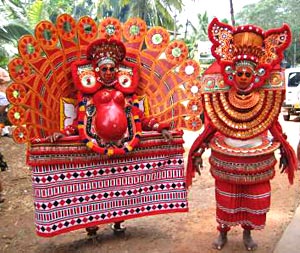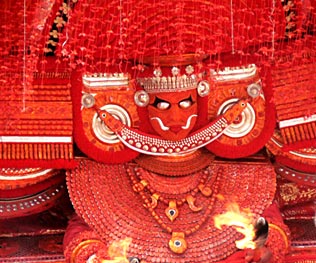 Teyam is the ritualistic form in the north Kerala districts of Kannur and Kasaragod. This is performed in shrines known by different names like Kavu, Mundiya, Palliyara, houses, ancestral homes, and public places, as a worshipful offering of the community. This intended for its common welfare. The person who transforms into a Teyyam acquired the right to officiate through family lineage. The major communities engaged in this religious practice are the Malayan, Vannan, Velan, Pulayan, Mavilon, and Koppalam. Generally an annual festival, its periodicity varies in certain temples to once in several years. When the ritual comes after several decades, widespread cooperation of many villages in the vicinity ensues and such an event is termed perumkaliyattam or grand festive enactment. In some cases it is conducted as an individual`s offering for attainment of material prosperity, warding off evil spells, or curing of diseases.
Teyam is the ritualistic form in the north Kerala districts of Kannur and Kasaragod. This is performed in shrines known by different names like Kavu, Mundiya, Palliyara, houses, ancestral homes, and public places, as a worshipful offering of the community. This intended for its common welfare. The person who transforms into a Teyyam acquired the right to officiate through family lineage. The major communities engaged in this religious practice are the Malayan, Vannan, Velan, Pulayan, Mavilon, and Koppalam. Generally an annual festival, its periodicity varies in certain temples to once in several years. When the ritual comes after several decades, widespread cooperation of many villages in the vicinity ensues and such an event is termed perumkaliyattam or grand festive enactment. In some cases it is conducted as an individual`s offering for attainment of material prosperity, warding off evil spells, or curing of diseases.
There exits a large variety of Teyyams. It belongs to gods and goddesses, war heroes, ancestors, animals, serpents, trees, and even devils. After their death, war heroes and ancestors are socially accepted as deified spirits. Godly spirits fall into three major categories. The names can be mentioned as Saiva, Vaishnava, and Shakta. Vettakkorumakan i.e. the son born to Siva and Parvati during a hunt, Vayanat Kulavan, Bhairavan, and Pottan are Saiva are usually dedicated to Siva. Vishnu Murti and Palottu Teyyam come under the Vaishnava group, dedicated to Vishnu. Bhagavati and Chamundi are of Shakta denomination, for Shakti. The prominent Kathivanur Viran belongs to the warrior class. Animals include Pullikkarimkali, Puliyurkali, Pulimarutan, and Bali. Ilanjikkal Bhagavati represents tree worship. Each is noted for specific make-up and outfits, designed on the basis of traditional colour concepts presenting the sentiments of the concerned spirit. They are gorgeous and mostly made of natural materials. The headgear i.e. upon a wooden frame can have several sizes and shapes. These are round, triangular, tower-like, fish-like,etc, and elaborately decorated to add to the Teyyam`s visual brilliance.
 The process of deification sometimes gives a mythic dimension to a local event. Ultimately this lower myth gets dissolved in an already existing popular higher myth. In Palemthayi Kannan, for example, an individual experience assumed mythicization and merged in the larger myth of Vishnu Murti, representing Vishnu`s Narasimha avatar. In Kathivanur Viran, which is based on a highly emotional village tale of love, the lover was martyred in war with a neighbouring state. His spirit became glorified as a Teyyam.
The process of deification sometimes gives a mythic dimension to a local event. Ultimately this lower myth gets dissolved in an already existing popular higher myth. In Palemthayi Kannan, for example, an individual experience assumed mythicization and merged in the larger myth of Vishnu Murti, representing Vishnu`s Narasimha avatar. In Kathivanur Viran, which is based on a highly emotional village tale of love, the lover was martyred in war with a neighbouring state. His spirit became glorified as a Teyyam.
Pottan is another noteworthy Teyyam in this context. The saint Shankaracharya once came across an untouchable Chandala or Pottan. Upper-caste Hindus believed in untouchability, and did not allow Chandalas to walk on the main road. When Sankaracharya saw him treading it, for fear of pollution he commanded him to move away. This led to argumentation between them on the soul`s inviolability and the evil practice of untouchability. Shankaracharya accepted defeat and fell at the feet of the Chandala, who enlightened him on non-dualistic Advaita philosophy. Sankaracharya`s becomes surprise and revealed himself as none other than Siva.
The Teyyam repertoire, with its rich variety of stories rendered as tottam i.e. narrative songs, describing the myth and its enactment. It provides the ethnic, religious, and socio-political experience of the people`s uninterrupted culture. The tottam details the exhaustive background against which the impersonator brings out the subtle feel of the Teyyam. The enactment does not literally convey the narrative, but highlights the emotional content through body movements, gestures, vocal articulation, costumes, and possession. The performer gets transformed into the spirit through several stages. While he and his associates sing the tottam, he continues in a possessed dance. The instruments accompanying the dance are chenda i.e. double-faced drum, cymbals, and sometimes kurumkuzhal i.e. a small double-reed pipe. Each Teyyam showers blessings in his peculiar way to devotees and distributes prasadam i.e. holy gifts. Mostly turmeric powder and in some cases ash, flowers, or rice are used as prasadam. Some Shakti Teyyams give toddy and alcohol as their favourite prasadam.




















